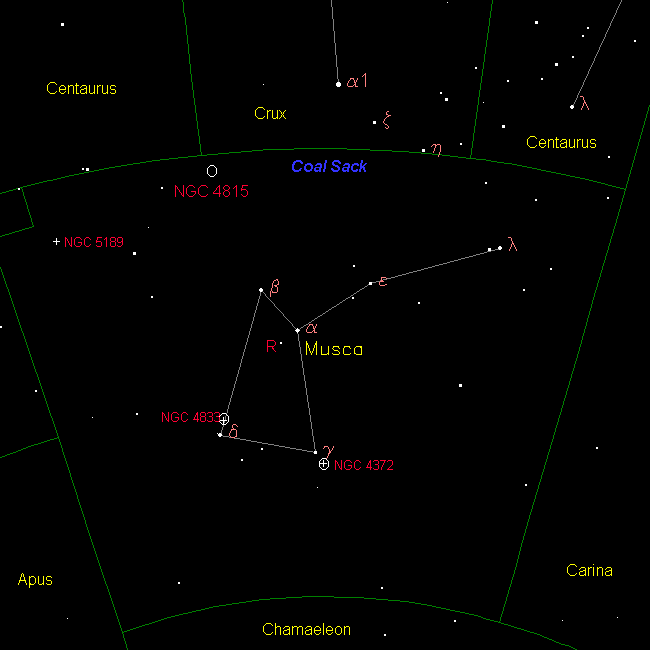[/caption]
The constellation of Musca was originally created by Petrus Plancius from the stellar observations of Dutch sea navigators Pieter Dirkszoon Keyser and Frederick de Houtman when exploring the southern hemisphere. Musca’s star patterns became known when it appeared on a celestial globe in 1597 and was considered a constellation named Apis when it was added to Johann Bayer’s Uranometria catalog in 1603, but it was misinterpreted as a fly instead of a bee! In 1752 Nicolas Louis de Lacaille renamed it to Musca Australis, the Southern Fly to avoid confusion with Apus. Today the name is simply Musca and it has survived the years – and the confusion – to become one of the 88 modern constellations recognized by the International Astronomical Union. Located south of the ecliptic plane and covering only 138 square degrees of sky, Musca ranks 77th in size among its peers. It has 6 main stars in its asterism and 13 Bayer Flamsteed designated stars within its confines. Musca is bordered by the constellations of Apus, Carina, Centaurus, Chamaeleon, Circinus and Crux. It is visible to observers located at latitudes between +10° and ?90° and is best seen at culmination during the month of May.
Since Musca is a “new” constellation, there is no mythology associated with it – only a bit of folklore. When Petrus Plancius drew the insect on his celestial globe in 1598, for some reason he didn’t put a name on the critter, although Frederick de Houtman had referred to it in his native Dutch as “the fly”. In 1603, Johannes Bayer also added it to his star charts as well – but misinterpreted the insect as a bee, calling it Apis. Apparently it was also charted in another 1603 work by Willem Janszoon Blaeu, who being Dutch, understood the correct language and labeled it as a fly. By the time it reached the hands of Abbe Nicolas Louis de Lacaille in 1752 it was corrected yet again to Musca Australis – the southern counterpart of Musca Borealis. No wonder the IAU was invented! It was finally shortened to just Musca and adopted as an official constellation in 1930.
Let’s begin our binocular tour of Musca with a look at its brighter star – Alpha Muscae – the “a” symbol on our map. This class B giant star is located about 305 light years from Earth and shines over 4500 times brighter than our own Sun. Is it hot? You bet. Alpha Muscae runs a stellar temperature of around 21,900 degrees Kelvin – so hot that most of its light is emitted in the ultra-violet range. It whirls around at its equator at a speed of 114 kilometers per second, making a full rotation in about 48 hours. And… it has a Beta Cepheid variable star heartbeat. It pulses. About every 2.2 hours it changes its magnitude just ever so slightly!
Now, hop over to Beta Muscae – the “B” symbol on our map. Beta is a binary star of almost equal magnitude. This pretty blue star isn’t easy to split and will require high magnification in a telescope and a fine, steady night of seeing. For an easier double star, try Eta Muscae (13h 15.4 min RA -67 55 Dec). You’ll find it wide, bright and easy… With a bonus binary star in the field, too! Theta Muscae (13h 08.1 min RA -65 18 Dec) is also another fine binary star that shows an interesting color contrast.
For both binoculars and telescopes, try your hand at globular cluster NGC 4833 (12h 59.6 min RA -70 53 Dec). At not quite magnitude 7, Caldwell 105 is well compressed and shows some great resolution in larger instruments. It was first discovered by Abbe Lacaille during his 1751-1752 journey to South Africa, and catalogued in 1755 – then later observed and catalogued by James Dunlop and Sir John Herschel whose instruments could resolve it into individual stars. Located about 21,200 light years from our solar system, it would be a whole lot brighter if it weren’t for the Milky Way Galaxy’s dust!
Keep your binoculars and telescopes handy for NGC 4372 (12h 25.8 min RA -72° 40 Dec). This slightly brighter globular cluster is a very loosely constructed Class XII discovered by James Dunlop on April 30, 1826. It’s very metal poor and observations by the XMM-Newton Telescope have shown the presence of close binaries which are “thought to play an important role in the stability of the clusters by liberating energy and delaying the inevitable core collapse of globular clusters”.
Small telescopes will enjoy open star cluster NGC 4815 (RA 12h 57m 59.0s Dec -64° 57′ 36.0″). What it lacks in size, it makes up for in richness. Unlike the “Jewel Box”, this little cluster suffers greatly from interstellar absorption. Enjoy this relative of the Hyades!
Mid-to-large telescopes will enjoy planetary nebula NGC 5189 (13h 33.6 min RA -65° 59 Dec). Nicknamed the “Spiral Planetary Nebula”, this little gem was discovered by John Herschel in 1835. Located about 3,000 light years away from Earth, NGC 5189 has been studied for its kinematic structure and contains an unusual expanding ring of gas that we see nearly edge-on.
While in Musca, take a look for the southern extension of the Coal Sack – a dark nebula. Located about 600 light years away, this obscuration cloud was was known to the people of the Southern Hemisphere in prehistoric times and has even been referred to historically as the “Black Magellanic Cloud”.

